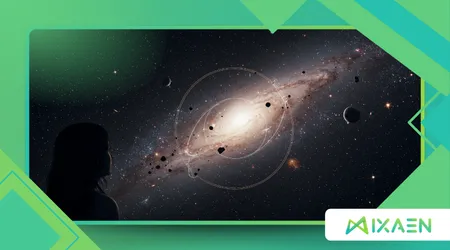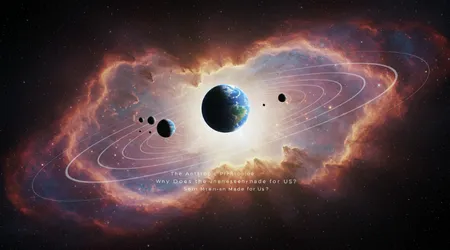The Anthropic Principle: Why Does the Universe Seem Made for Us?

The anthropic principle whispers a tantalizing question: why does the universe seem perfectly tuned for human existence?
Anúncios
From the delicate balance of physical constants to the improbable emergence of life, the cosmos appears crafted with uncanny precision.
This concept, bridging cosmology and philosophy, challenges our understanding of reality. Is the universe designed for us, or are we merely a fortunate accident?
This article dives deep into the anthropic principle, exploring its implications, scientific underpinnings, and philosophical weight, with fresh insights for 2025.
The anthropic principle first emerged in the 1970s, notably through physicist Brandon Carter. It suggests the universe’s laws seem fine-tuned for life because we’re here to observe them.
This idea sparks debates across disciplines. Scientists, philosophers, and even theologians wrestle with its meaning.
Does it point to a purposeful cosmic design, or is it a tautology masking deeper truths? Let’s unravel this enigma, weaving through science, philosophy, and the human quest for meaning.
This exploration will navigate the anthropic principle’s scientific roots, its philosophical dimensions, and its role in modern cosmology.
Expect clear examples, a touch of skepticism, and a dash of wonder.
By the end, you’ll see why this principle captivates minds in 2025, from researchers to curious stargazers. So, why does the universe feel like it was made for us? Let’s find out.
The Science Behind the Anthropic Principle
The anthropic principle hinges on the universe’s physical constants, like gravity’s strength or the electron’s charge. These values are eerily precise for life.
Change them slightly, and stars wouldn’t form, or chemistry would collapse. For instance, the fine-structure constant, roughly 1/137, governs electromagnetic interactions. A 1% shift could unravel atoms, making life impossible.
This precision fuels the anthropic principle. In 2018, physicist Luke Barnes noted that the odds of a life-friendly universe are less than 1 in 10^100.
Such numbers boggle the mind, suggesting either incredible luck or something more. Imagine a cosmic dial, each knob set perfectly for life.
One wrong turn, and galaxies vanish. This analogy underscores the principle’s core: we observe a life-friendly universe because we exist.
Yet, science demands rigor. The anthropic principle doesn’t “explain” why constants are precise; it observes that they must be for us to ponder them.
Critics argue it’s circular logic. Still, it pushes scientists to explore why these constants hold.
Recent 2025 studies, like those from the Perimeter Institute, probe whether quantum gravity could unlock these mysteries, keeping the principle relevant.
The multiverse theory offers another angle. If countless universes exist with varying constants, we’d naturally find ourselves in one suited for life.
++ The Simulation Hypothesis: Are We Living in a Computer Program?
This idea, while unproven, gains traction in cosmology. It’s like picking the one winning lottery ticket from billions someone had to win, and it’s us.
But the multiverse isn’t the only lens. Some physicists, like Sabine Hossenfelder in 2025, argue the anthropic principle overcomplicates things.
Maybe constants aren’t “tuned” but inevitable, fixed by unknown physics. This debate keeps the principle alive, urging scientists to test theories against cosmic realities.

Philosophical Implications of the Anthropic Principle
Why does the universe seem tailored for us? This question drives the anthropic principle into philosophy’s heart. It challenges our place in the cosmos.
If the universe is fine-tuned, does it imply a purposeful intelligent design? Philosophers like John Leslie argue it suggests a cosmos with intent, though not necessarily a deity.
Contrastingly, the anthropic principle can feel like a cosmic shrug. Atheist thinkers like Richard Dawkins see it as tautological: we’re here, so the universe must support life.
No deeper meaning required. This tension fuels debates in 2025, as philosophers grapple with existential questions in a post-AI world.
Also read: Is Time an Illusion? Philosophical Views on Time
Consider a practical example: a puddle marveling at how perfectly its hole fits its shape. This analogy, inspired by Douglas Adams, suggests we might be overinterpreting the universe’s “fit” for us.
Maybe we’re just adapted to what’s here. Yet, the principle persists, inviting reflection on our cosmic role.
The principle also touches on free will. If the universe is “made” for us, are our choices predetermined by its structure?
Philosophers in 2025, like those at Oxford’s Future of Humanity Institute, explore this, linking it to AI’s rise and human agency.
Finally, the anthropic principle sparks ethical questions. If we’re uniquely positioned in a life-friendly universe, do we have a duty to preserve it?
Read more: What Is the Multiverse Theory and Why It Matters Now More Than Ever?
This resonates in 2025, as climate crises and space exploration dominate headlines, urging humanity to act responsibly.
The Anthropic Principle in Modern Cosmology
In 2025, the anthropic principle shapes cutting-edge cosmology. Researchers at CERN and the James Webb Space Telescope probe cosmic origins, seeking clues to why constants align for life.
The principle guides questions about dark energy, which drives the universe’s expansion at just the right pace for galaxies to form.
The multiverse remains a hot topic. String theory suggests 10^500 possible universes, each with unique physics.
If true, the anthropic principle explains why we’re in a rare, life-friendly one. Think of a cosmic library, each book a universe ours is the one we can read.
Yet, the principle faces skepticism. Some cosmologists argue it sidesteps hard questions. Why these constants? Why this universe?
In 2025, experiments like the Simons Observatory hunt for cosmic microwave background patterns, testing multiverse predictions indirectly.
Another angle is simulation theory. If we’re in a simulated universe, the anthropic principle could reflect a programmer’s choices.
In 2025, tech advances make this idea less sci-fi, with philosophers like Nick Bostrom exploring its plausibility.
The principle also inspires practical science. For example, astrobiologists use it to prioritize exoplanet searches, focusing on worlds with Earth-like conditions.
This focus drives 2025 missions, like NASA’s Habitable Worlds Observatory, aiming to find life-friendly planets.
| Physical Constant | Role | Impact if Altered |
|---|---|---|
| Fine-structure constant | Governs electromagnetic interactions | Atoms destabilize, no chemistry |
| Gravitational constant | Controls gravity’s strength | Stars or galaxies fail to form |
| Cosmological constant | Drives universe’s expansion | Universe collapses or expands too fast |
The Anthropic Principle and Human Perspective
The anthropic principle isn’t just academic it reshapes how we view ourselves. It suggests our existence isn’t random but tied to cosmic structure.
This can feel empowering, like being the protagonist in a grand story, yet humbling, as we’re one species among billions of possibilities.
In 2025, this resonates deeply. AI advancements and space exploration make us question our uniqueness. Are we special, or just a statistical fluke?
The principle invites us to ponder this, like stargazers wondering if the night sky was painted for them.
Culturally, the anthropic principle influences art and media.
A 2025 sci-fi novel, Cosmic Fit, imagines humans discovering a universe coded for their survival, sparking ethical dilemmas. Such stories reflect our fascination with our place in the cosmos.
It also informs policy. If the universe is uniquely suited for life, preserving Earth becomes urgent.
In 2025, global summits cite the principle when advocating for sustainable space exploration, tying cosmology to real-world action.
Finally, it’s personal. The anthropic principle asks: what does it mean to be human in a universe that seems to want us here?
This question drives introspection, connecting science to the human spirit in 2025’s fast-evolving world.

Conclusion
The anthropic principle is more than a scientific curiosity it’s a mirror reflecting our place in the cosmos. It asks why the universe fits us so well, blending hard science with profound philosophy.
From fine-tuned constants to multiverse theories, it challenges us to rethink reality. In 2025, as we probe the stars and wrestle with AI’s rise, this principle remains a beacon, guiding our quest for meaning.
It’s not just about equations or distant galaxies. The anthropic principle invites us to marvel at our existence, to question whether we’re a cosmic accident or something more.
As we stand on the cusp of new discoveries, it reminds us to stay curious, humble, and open to the universe’s mysteries. So, reader, what do you think did the cosmos roll the dice, or was it always meant for us?
FAQs About the Anthropic Principle
What is the anthropic principle?
It’s the idea that the universe’s laws seem fine-tuned for life because we’re here to observe them, with strong and weak versions debated.
Does the anthropic principle prove the universe was designed?
No, it observes life-friendly conditions but doesn’t confirm design. It’s a starting point for scientific and philosophical exploration, not proof.
How does the multiverse relate to the anthropic principle?
The multiverse suggests many universes with different laws. The principle explains why we’re in one suited for life because we couldn’t be elsewhere.
Is the anthropic principle scientific or philosophical?
It’s both. It’s rooted in physics’ fine-tuned constants but sparks philosophical debates about design, purpose, and our cosmic role.
